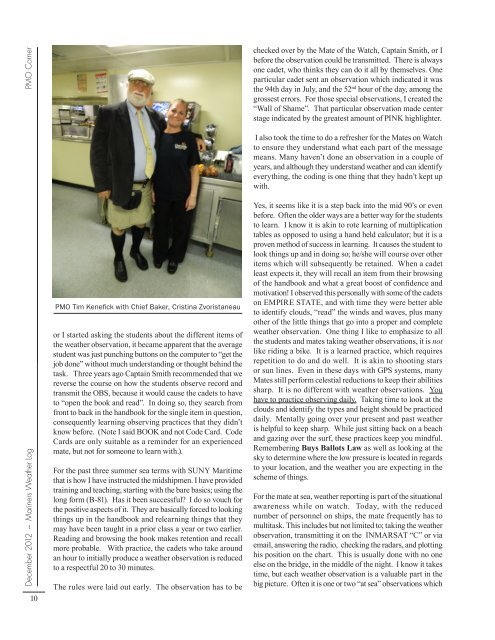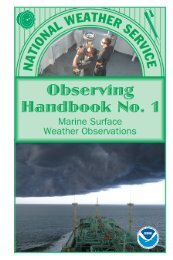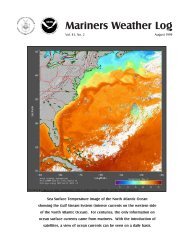Volume 56, Number 3 December 2012 Photo by Denice Drass
Volume 56, Number 3 December 2012 Photo by Denice Drass
Volume 56, Number 3 December 2012 Photo by Denice Drass
Create successful ePaper yourself
Turn your PDF publications into a flip-book with our unique Google optimized e-Paper software.
pMO Corner<br />
<strong>December</strong> <strong>2012</strong> ~ Mariners Weather Log<br />
10<br />
PMO Tim Kenefick with Chief Baker, Cristina Zvoristaneau<br />
or I started asking the students about the different items of<br />
the weather observation, it became apparent that the average<br />
student was just punching buttons on the computer to “get the<br />
job done” without much understanding or thought behind the<br />
task. Three years ago Captain Smith recommended that we<br />
reverse the course on how the students observe record and<br />
transmit the OBS, because it would cause the cadets to have<br />
to “open the book and read”. In doing so, they search from<br />
front to back in the handbook for the single item in question,<br />
consequently learning observing practices that they didn’t<br />
know before. (Note I said BOOK and not Code Card. Code<br />
Cards are only suitable as a reminder for an experienced<br />
mate, but not for someone to learn with.).<br />
For the past three summer sea terms with SUNY Maritime<br />
that is how I have instructed the midshipmen. I have provided<br />
training and teaching, starting with the bare basics; using the<br />
long form (B-81). Has it been successful? I do so vouch for<br />
the positive aspects of it. They are basically forced to looking<br />
things up in the handbook and relearning things that they<br />
may have been taught in a prior class a year or two earlier.<br />
Reading and browsing the book makes retention and recall<br />
more probable. With practice, the cadets who take around<br />
an hour to initially produce a weather observation is reduced<br />
to a respectful 20 to 30 minutes.<br />
The rules were laid out early. The observation has to be<br />
checked over <strong>by</strong> the Mate of the Watch, Captain Smith, or I<br />
before the observation could be transmitted. There is always<br />
one cadet, who thinks they can do it all <strong>by</strong> themselves. One<br />
particular cadet sent an observation which indicated it was<br />
the 94th day in July, and the 52 nd hour of the day, among the<br />
grossest errors. For those special observations, I created the<br />
“Wall of Shame”. That particular observation made center<br />
stage indicated <strong>by</strong> the greatest amount of PINK highlighter.<br />
I also took the time to do a refresher for the Mates on Watch<br />
to ensure they understand what each part of the message<br />
means. Many haven’t done an observation in a couple of<br />
years, and although they understand weather and can identify<br />
everything, the coding is one thing that they hadn’t kept up<br />
with.<br />
Yes, it seems like it is a step back into the mid 90’s or even<br />
before. Often the older ways are a better way for the students<br />
to learn. I know it is akin to rote learning of multiplication<br />
tables as opposed to using a hand held calculator; but it is a<br />
proven method of success in learning. It causes the student to<br />
look things up and in doing so; he/she will course over other<br />
items which will subsequently be retained. When a cadet<br />
least expects it, they will recall an item from their browsing<br />
of the handbook and what a great boost of confidence and<br />
motivation! I observed this personally with some of the cadets<br />
on EMPIRE STATE, and with time they were better able<br />
to identify clouds, “read” the winds and waves, plus many<br />
other of the little things that go into a proper and complete<br />
weather observation. One thing I like to emphasize to all<br />
the students and mates taking weather observations, it is not<br />
like riding a bike. It is a learned practice, which requires<br />
repetition to do and do well. It is akin to shooting stars<br />
or sun lines. Even in these days with GPS systems, many<br />
Mates still perform celestial reductions to keep their abilities<br />
sharp. It is no different with weather observations. You<br />
have to practice observing daily. Taking time to look at the<br />
clouds and identify the types and height should be practiced<br />
daily. Mentally going over your present and past weather<br />
is helpful to keep sharp. While just sitting back on a beach<br />
and gazing over the surf, these practices keep you mindful.<br />
Remembering Buys Ballots Law as well as looking at the<br />
sky to determine where the low pressure is located in regards<br />
to your location, and the weather you are expecting in the<br />
scheme of things.<br />
For the mate at sea, weather reporting is part of the situational<br />
awareness while on watch. Today, with the reduced<br />
number of personnel on ships, the mate frequently has to<br />
multitask. This includes but not limited to; taking the weather<br />
observation, transmitting it on the INMARSAT “C” or via<br />
email, answering the radio, checking the radars, and plotting<br />
his position on the chart. This is usually done with no one<br />
else on the bridge, in the middle of the night. I know it takes<br />
time, but each weather observation is a valuable part in the<br />
big picture. Often it is one or two “at sea” observations which






